Facilities
Confocal microscope for micro-photoluminescence (polarization-resolved) of single nano-objects under magnetic field
• spatial resolution of about 1 micron at 950 nm. Monochromator Acton Spectra Pro 500i (gratings 300t/mm, 600t/mm, 1200t/mm blazed à 1 micron) CCD Roper cooled at 77K
• Piezoelectric motors Attocube working at 1,7 K
• Cryogenics He liquid Cryostat (1,7-300K) with supra coil (magnetic field up to 13 T)
• Attocube Attodry 700 Cryostat (3-300K) low vibration, closed cycle He
• SPAD (time resolution 300 ps)
• Perrot-Fabry Interferometer Burleigh RC110
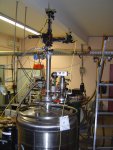

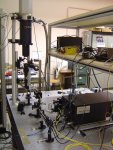
Polarization-resolved electroluminescence devices for the study of spin injection
a) cw – Electroluminescence
• Monochromator Jobin-Yvon HRS1 (focal 58,8 cm, grating 600t/mm blazed at 1 micron)
• CCDCamera Ropper cooled at -100°C (low noise Peltier system)
• Magnetice Field from 0 à 0,8 T with Helmoltz coil
• I(V) charactrization
• Signal generator HP 8160A
b) Time resolved electroluminescence
• Ultra-fastpulses generators: 85ps at room temperature, 250ps at 15K, adjustable pulsesbetween 600 ps-1ns-2ns-4ns-10 ns with rise and fall time of about 150ps à 15K
• Streakscope with photocathode S20 (450-850 nm)(resolution 25 ps, 2 MHz)
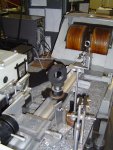



Stationary photoluminescence devices in the visible and UV
• UV Laser Spectra Beamlok 351 nm 400 mW
• Monochromator Acton spectra pro 2500i (focal : 50 cm)
• CCD camera Ropper cooled down at 77K

Photocurrent and photoconductivity devices
a) Photocurrent
• White lamp (200 nm1,4 microns) 2W/cm2
• Monochromator (focal 70 cm)
• lock-in amplifier EG&G 5206
• Liquid nitrogen cryostat
b)Polarization resolved photocurrent
• Ti-Sa Laser,cwtunable (0-1,8 W 700-950 nm)
• PhotoelasticModulator 50 kHz, lock-in amplifier 200kHz
• Longitudinal magneticfieldfrom 0 à 0, 8 T with Helmoltz coil
c) Polarization resolved photoconductivityin the infrared
d) Photoconductivityin the UV


Time-resolved (and polarization) photoluminescence measurements in the near infrared
Sources :
• Ti:Sa Lasers (82 Mhz, 1.5ps/10ps ; 0.7-1µm) pumped by Verdi 10W
• Optical ParametricOscillator (82 Mhz, 1.5 ps/200 fs, 1-1.6 µm)
Detection units :
a) Streak camera synchro-scan, with photocathode S1, (82 MHz, time resolution 5 ps, spectral 0.4-1.5 µm) -Spectrometer Jobin-Yvon Triax 320
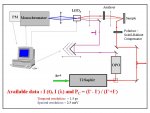




Time-resolved (and polarization) photoluminescence measurements in the UV
Sources :
• Ti:Sa Lasers (82 MHz, 1.5ps/10ps ; 0.7-1µm) pumped by Verdi 10W
• Doublre-triplerfrequencies (82 Mhz, 1.5 ps, spectral range 340-470 nm et 260-310 nm)
Detection units:
a) Streak camera Synchro-scan, photocathode S20, (82 MHz, temporal resolution 5 ps, spectral range (200-800 nm)
• spectrometer Horiba iHRS320
b) Photomultiplier Hamamatsu R3809U-50, temporal resolution 40 ps, spectral range (200-800 nm)

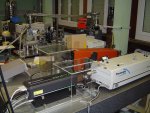
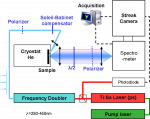
Other experimental tools
• Ti-sa laser cw tunable (0-1,8 W 700-950 nm)
• Nd-Yag laser Q switch tunable 0,7m-1,6m, 20 ps, 10 Hz, 200 J/ pulse, or double amplifier (30 ps, 50mJ/pulse)
• 2 Cryo-generatorswith closed He cycle (10-300 K)
• Superconducting coil in optical cryostats (1.7K ; 5 T Faraday geometry, 4 T in Voigt geometry).
